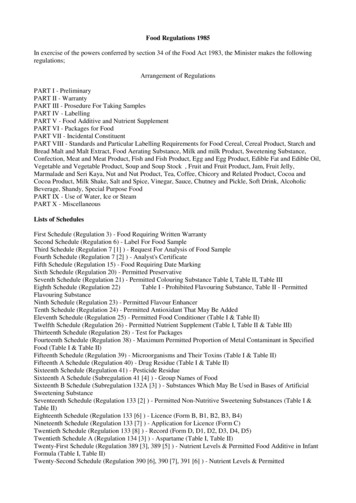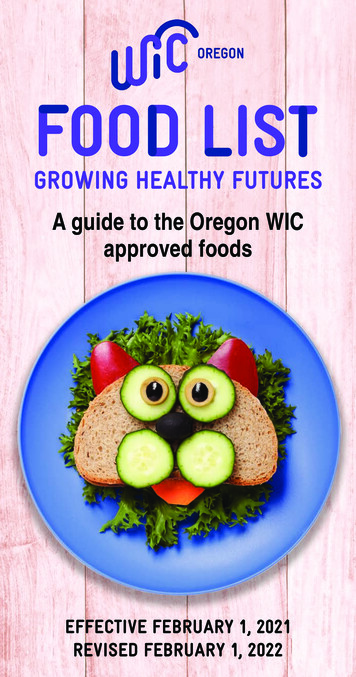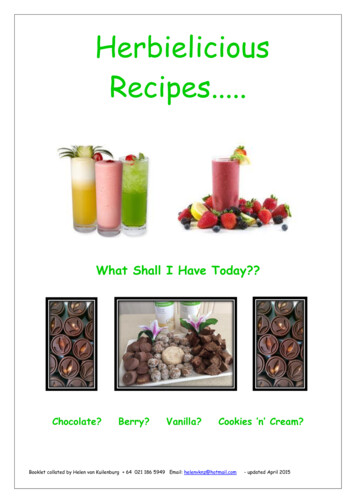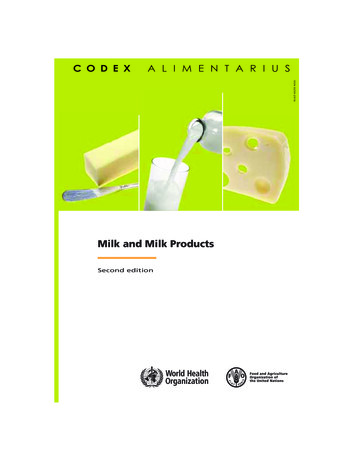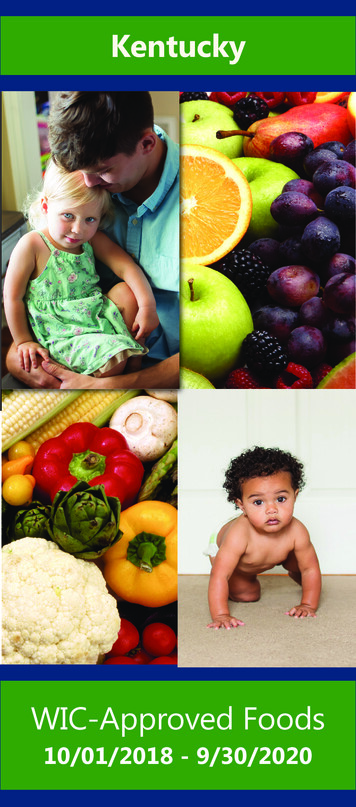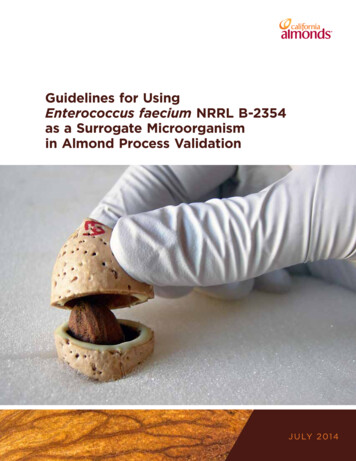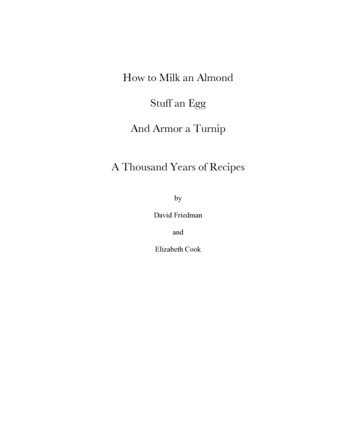
Transcription
How to Milk an AlmondStuff an EggAnd Armor a TurnipA Thousand Years of RecipesbyDavid FriedmanandElizabeth Cook
David Friedman and Elizabeth Cook,1988, 1990, 1992, 1996, 1998, 2000, 2011ISBN: 978-1-460-92498-3Copies may be purchased online fromhttps://www.createspace.com/3565795If you wish to reproduce or reprint anything in this book, you may do so subject to the following conditions:1. The material should be accompanied by a credit line giving the source and author.2. Any article or recipe that is quoted must be quoted in full, with no changes, deletions, or additions.3. If you are making more than 100 copies, you must first get permission from the author.4. Recipes may be quoted on web pages, provided that the source is credited. We would appreciate a link to the onlineversion of this volume, at the URL below.http://www.daviddfriedman.com/Medieval/To Milk an Almond.pdf
To the memory ofMarion Walke
IntroductionThe Society for Creative Anachronism is agroup that does historical recreation from theMiddle Ages and Renaissance. Some of itsevents are feasts. When I discovered it, aboutforty years ago, it struck me that medievalfeasts with diners in medieval clothing oughtto have medieval food.I found collections of English recipes fromthe fourteen and fifteenth centuries compiledby nineteenth century enthusiasts, along with atranslation of a thirteenth century Arabiccookbook published in a scholarly journal inthe nineteen thirties. Over the years since, mycollection of sources has expanded, in partthrough translations by fellow enthusiasts,among them my wife and daughter.Most period recipes omit inessential detailssuch as quantities, temperatures, and times.You take some of this and enough of that, cookit until it is done, add a bit of something elseand serve it forth. The problems of gettingfrom that to something that tastes good makecooking from Two Fifteenth Century CookeryBooks more interesting than cooking fromFanny Farmer. And you end up with a dishthat, as best you can tell, nobody else has madefor the past five hundred years. Think of it asexperimental archaeology.This volume contains the result of my andmy wife’s efforts, assisted by lots of otherpeople, at working out period recipes. Eachrecipe starts with the original or a translationof the original, followed by information onhow we make it. One of the things I havelearned from reading secondary sources onhistorical cooking is that you should nevertrust a secondary source that does not includethe primary, since you have no way ofknowing what liberties the author may havetaken in his “interpretation” of the recipe.The volume also contains a number ofrelatedarticles—whatfoodstuffswereavailable when, how to produce a medievalfeast, and much else. It is a selection from alonger volume intended for readers active inthe SCA, a Miscellany covering medievalcooking and much else that has gone throughnine self-published editions and will shortly beavailable in a tenth. For readers unfamiliarwith the organization, it is worth explainingthat members adopt “personae” with periodnames, some of which appear here. Mine is aNorth African Berber named Cariadoc fromabout 1100 A.D.Enjoy.David FriedmanIf you would like to discuss any of theissues raised in the articles, exchange recipes,volunteer to translate cookbooks, orcorrespond with us on any other subject, ouraddress is:David Friedman and Betty Cook(Cariadoc and Elizabeth)3806 Williams Rd.,San Jose, CA /Medieval/Medieval.html
Table of rlyPeriodEnglish/French13th- 15thc.English16th- 4656872IslamicDishes:MiddleEastandal- nsic135138145146147150155157158
1RecipesThe sources of these recipes range, with afew exceptions, from the sixth century to thesixteenth. The original, or an Englishtranslation of the original, is given inchancery font, followed by a list ofingredients with quantities and, usually butnot always, additional instructions. For a fewof the less readable early English recipes wealso give a modernized version of the originaltext. The only intentional modifications wehave made are to modernize the spelling insome recipes and to omit the medicalcomments which Platina (routinely) and theauthors of the Andalusian cookbook(occasionally) include in their recipes.How well worked out the recipes arevaries; some we have been doing for manyyears, others are the result of one or two tries.Before serving to anyone other than closefriends and fellow cooking enthusiasts, try therecipe out at least once and adjust it to taste.Sources for RecipesEarly PeriodAnthimus, De Observatio Ciborum,translated by Shirley Howard Weber,published by E. J. Brill Ltd, Leiden 1924. Thisis a letter on the subject of diet, written in thesixth century by a Byzantine physician toTheoderic, King of the Franks. It includesseveral recipes.Apicius, The Roman Cookery Book, tr.Barbara Flower and Elisabeth Rosenbaum,George G. Harrap & Co. Ltd., London, 1958.This is a recommended translation andincludes the Latin original. The earliertranslation by Vehling is not recomended, ashe changes the recipes considerably.English/French 13th-15th c.Ancient Cookery from A Collection of theOrdinances and Regulations for theGovernment of the Royal Household made inDivers Reigns from King Edward III to KingWilliam and Queen Mary also Receipts inAncient Cookery, printed for the Society ofLondon Antiquaries by John Nichols, 1740.The recipes are from the early 15th century.Curye on Inglysch: English CulinaryManuscripts of the Fourteenth Century(Including the Forme of Cury), edited byConstance B. Hieatt and Sharon Butler,published for the Early English Text Societyby the Oxford University Press, 1985. Still inprint as of 2010.The Forme of Cury, A Roll of AncientEnglish Cookery, ed. S. Pegge, printed for theSociety of London Antiquaries by JohnNichols, 1780. This is English c. 1390; for alater edition see Curye on Inglysch above.Constance B. Hieatt, An Ordinance ofPottage, Prospect Books, London, 1988 (15thc. English).Constance B. Hieatt and Robin F. Jones,Two Anglo-Norman Culinary CollectionsEdited from British Library ManuscriptsAdditional 32085 and Royal 12.C.xii,Speculum v. 61 n. 4, pp. 859-882, 1986.Referred to below as “Anglo-Norman.”Le Menagier de Paris, 1395, tr. JanetHinson (Lady Mairoli Bhan); also translatedas The Goodman of Paris, Power and Coulton,tr., but with only selections from the recipes.Recipes from Power and Coulton are given as“Goodman;” recipes from Hinson are given as“Menagier.” Page references are to volume IIof the collection of source material we used tosell. The Hinson translation is webbed ier/Menagier Contents.htmlA Noble Boke off Cookry Ffor a PrynceHoussolde, ed. Mrs. Alexander Napier, 1882(c. 1470).Chiquart, Du Fait de Cuisine, 1420, tr. byElizabeth from the French original publishedby Terence Scully in Vallesia v. 40, pp. 101231, 1985. There is also a publishedtranslation by Scully. Elizabeth's transation iswebbed at:www.daviddfriedman.com/Medieval/Cookbooks/Du Fait de Cuisine/du fait de c contents.html
2Pepys 1047. Published as Stere Hit Well:Medieval recipes and remedies from SamuelPepys's Library. Modern English version byG.A.J. Hodgett. The modern English versionis unreliable but the book includes a facsimileof the late fifteenth century original.Two Fifteenth Century Cookery Books(1430-1450), Thomas Austin Ed., EarlyEnglish Text Society, Oxford UniversityPress, 1964.Le Viandier (c. 1392), Taillevent. Ourrecipes are from a partial translation byElizabeth Bennett [Mistress Alys Gardyner];two complete translations have also beenpublished.English 16th-17th c.Sir Kenelm Digby, The Closet of SirKenelmDigby,Opened(publishedposthumously in 1669). This is slightly out ofperiod, but contains the earliest collection offermented drink recipes that we know of.Some of this is webbed at:realbeer.com/spencer/digby.htmlThe English Huswife, by GervaseMarkham (1615, but Mistress Marion informsus that Markham is a notorious plagiarist, sothe material is probably somewhat earlier).Sir Hugh Platt, Delights for Ladies,London, 1609.A Proper Newe Booke of Cokerye, ed.Catherine Frances Frere, Cambridge, W.Heffer and sons, Ltd., 1913 (16th century).GermanDaz Buoch von Guoter Spise (between1345 and 1354), tr. Alia Atlas. Webbed abina Welser's Cookbook, tr. from DasKochbuch der Sabina Welserin (c. 1553) byValoise Armstrong, Little Rock, Arizona,1998. Webbed na Welserin.htmlItalian, Spanish and PortuguesePlatina, De Honesta Voluptate, Venice, L.De Aguila, 1475. Translated by E. B.Andrews, Mallinkrodt 1967. (Both Platina andKenelm Digby were published as part of the“Mallinkrodt Collection of Food Classics.”)Reprinted by Falconwood Press, 1989. Pagenumbers given herein are from theFalconwood edition. This is the version wehave worked from; a new and (I gather)inproved translation is Platina, On RightPleasure and Good Health, tr. Mary EllaMilham, Medieval and Renaissance Texts andStudies, Tempe, Arizona, 1998.Due Libre B, An Early 15th CenturyRecipe Collection from Southern Italy.Translated by Rebecca Friedman. Webbed s/Due Libre B/Due Libre B.htmlEpulario, or, The Italian Banquet, London,1598. Reprinted Falconwood Press, Albany,NY, 1990. This is a late-period Englishtranslation of an Italian cookbook with a lot ofoverlap with Platina, including some of thesame sequences of recipes and at least onetypo in common.Messibugio, Libro Novo 1557. Translatedby Master Basilius (Charles Potter).Diego Granado, Libro del arte de cozina,1599. A few recipes from this have beentranslated by Lady Brighid ni Chiarain ofTethba, Settmour Swamp (Robin CarrollMann).Ruperto de Nola, Libro de Guisados, 1529.Translated by Robin Carroll-Mann (LadyBrighid ni Chiarain). Webbed S/Guisados1-art.htmlUm Tratado Da Cozinha Portuguesa DoSeculo XV (A Text on Portuguese Cookingfrom the Fifteenth Century). Translated byJane L. Crowley with the assistance of amodern Portuguese text by Professor AntonioGomes Filho. Referred to as “Portuguese”below.Islamic and IndianAin-I-Akbari (part of the Akbarnama) byAbu al-Fazl ibn Mubarak, H. Blochmann tr.,edited by D. C. Phillott, Calcutta 1927. Anaccount of Mughal India, especially Akbar'scourt, in the late 16th century. It includes
3ingredient lists (with quantities but withoutinstructions) for thirty dishes and descriptionsof how to make bread and arrack. Webbed googAl-Baghdadi, A Baghdad Cookery Book(1226 A.D./623 A.H.), A.J. Arberry, tr.,Islamic Culture 1939, and republished inMedieval Arab Cookery (see below). There isnow a new and probably better translation byCharles Perry, but we have not yet used it.An Anonymous Andalusian Cookbook ofthe Thirteenth Century, a translation byCharles Perry of the Arabic edition ofAmbrosio Huici Miranda with the assistanceof an English translation by Elise Fleming,Stephen Bloch, Habib ibn al-Andalusi andJanet Hinson of the Spanish translation byAmbrosio Huici Miranda, webbed s/Andalusian/andalusian contents.htm.Referred to below as “Andalusian.” Pagereferences are to volume II of the collection ofsource material we used to sell.Annals of the Caliph's Kitchen, Ibn Sayyaral-Warraq, translated by Nawal Nasrallah.Tenth century. We also have a few recipesfrom the same source translated by CharlesPerry.La Cocina Arabigoandaluza, translatedfrom Arabic into Spanish by Fernando de laGranja Santamaria and from Spanish intoEnglish by Melody Asplund-Faith. Thisconsists of selections from a much longerArabic original. It is referred to below as “alAndalusi.”Medieval Arab Cookery, Essays andTranslations by Maxime Rodinson, A.J.Arberry & Charles Perry, Prospect Books,1998. Contains, along with much else, Kitabal Tibakhah: A Fifteenth-Century Cookbook,Charles Perry, tr., original author Ibn alMubarrad. Also The Description of FamiliarFoods, a cookbook based on al-Baghdadi withadditional recipes.The Ni'matnama Manuscript of the Sultansof Mandu: The Sultan's Book of Delights,translated by Norah M. Titley, Routledge,2005. An Indian source c. 1500.ChinesePaul D. Buell and Eugene N. Anderson, ASoup for the Qan: Chinese Dietary Medicineof the Mongol Era as Seen in Hu Szu-Hui'sYin-ShanCheng-Yao,KeganPaulInternational, London and New York, 2000. Atranslation of a Chinese/Mongol medical bookwith extensive commentary, including recipesfor both food and medicinals.Teresa Wang and E.N. Anderson, Ni Tsanand His 'Cloud Forest Hall Collection ofRules for Drinking and Eating', Petits ProposCulinaires #60‡,, 1998. See also “Someremarks about the translation of Yun LintangYinshi Zhidu Ji” published in PPC 60 byFrancoise Sabban, which has corrections andalternative translations.OtherThe Domostroi: Rules for RussianHouseholds in the Time of Ivan the Terrible,edited and translated by Carolyn JohnstonPouncy, Cornell University Press: Ithaca1994. A Russian household managementmanual, most of which is probably from the16th century, including a few recipes and agood deal of information about food.Rudolf Grewe, “An Early XIII CenturyNorthern-EuropeanCookbook,”inProceedings of A Conference on CurrentResearch in Culinary History: Sources,Topics, and Methods. Published by theCulinary Historians of Boston, 1986. This isan article attempting to reconstruct the lostoriginal from which several survivingmanuscripts, including the one we refer to as“A selection from An Old Icelandic MedicalMiscelleny,” descend.A Selection From An Old IcelandicMedical Miscelleny, ed. Henning Larson,Oslo, 1931. For a more recent edition, seeGrewe.‡: Petits Propos Culinaires is an internationaljournal on food, food history, cookery and cookerybooks. See: http://rdeh.tripod.com/
4Mappae Clavicula: a Little Key to theWorld of Medieval Techniques, tr. CyrilStanley Smith and John G. Hawthorne,Transactions of the American PhilosophicalSociety, Philadelphia, 1974. This is acollection of technical recipes which includesthree candy recipes; the manuscript translatedhere dates to the 12th c. but there are earlierversions with fewer recipes going back to the9th c.IngredientsAsafoetida: Strongly flavored spiceavailable in Indian grocery stores, referred toas “hing” or “heeng”.Beef Broth: Canned beef broth is usuallyconcentrated; what we use is either that,diluted in an equal quantity of water, or beefbroth from beef bullion—1 cube per cup ofwater.Camphor: Edible camphor can sometimesbe found in Indian grocery stores; it is verystrongly flavored.Cassia, aka chinese cinnamon: Cassia iswhat is usually sold as cinnamon in the U.S.,as distinguished from “true cinnamon,” aka“ceylon cinnamon.” The two spices havesimilar but not identical flavors.Clarified butter, aka ghee: Available inIndian grocery stores; Indian cookbooks oftenhave instructions for making it.Coriander: Unless described as fresh weinterpret it as meaning coriander seed, withthe leaf of the same plant labelled “cilantro.”Date syrup, aka dibs: Can sometimes befound in Middle Eastern grocery stores.Galingale: A root similar in appearance toginger, used in Thai cooking, and sold inoriental grocery stores, fresh or ground,sometimes as “Galingas.”Ghee: Clarified Butter.Gourd aka pumpkin: Modern squashes andpumpkins are from the New World; theproblem of identifying the old worldequivalent is discussed in the article “LatePeriod and Out of Period Foods.” (p. 138).Our best guess is the opo gourd, oftenavailable in Chinese grocery stores in the U.S.Mastic: A strongly flavored resin; I like todescribe it as dehydrated turpentine. TryMiddle Eastern or Indian groceries and use itin very small quantities.Oranges/orange juice: in Europe and theMiddle East before about the 16th century, thiswould have meant sour oranges. For more oncitrus fruit, see p. 140.Powder fort: A spice mixture mentioned invarious period recipes; we have not yet beenable to find a description of what spices itcontains. What we use is a mixturecontaining, by weight: 1 part cloves, 1 partmace, 1 part cubebs, 7 parts cinnamon, 7 partsginger, and 7 parts pepper, all ground. This isa guess, based on very limited evidence; itworks for the dishes in which we have tried it.Poudre douce: A sweet spice mixture. Thecomposition probably varied; we usually use amix of four parts sugar, 2 parts cinnamon, and1 part ginger.Samidh flour: Described in the al-Warraqtranslation as “the finest variety of whitewheat flour.” Charles Perry thinks it may besemolina, but is not sure; that is what we haveused. Cake flour is one possible alternative.Sesame Oil: In Islamic recipes, this is theclear to yellowish sesame oil sold in MiddleEastern grocery stores, which is made fromuntoasted sesame seeds and has only a slightflavor; something very similar can be found inhealth food stores. Chinese sesame oil, whichis much darker, is made from toasted sesameseeds and is very strongly flavored.Sumac: A sour red powder, found inIranian grocery stores (and restaurants).Tarot: A starchy root that can sometimesbe found in Chinese grocery stores.Tail: Fat from the tail of a fat-tailed sheep,used as a cooking oil in Islamic recipes. Sinceit is not available at the local butcher, wesubstitute lamb fat.Verjuice: Sour juice, usually from unripegrapes. We use sour grape juice from MiddleEastern grocery stores. Dilute vinegar can beused as a substitute; two parts of verjuiceseems to be roughly equivalent to one part ofvinegar. Verjuice produced for the gourmettrade and priced accordingly has becomeincreasingly common over the last few years.
5Wheat Starch (Amidoun): Can be found inIranian grocery stores.Other Spices: For cubebs, grains ofparadise, and long pepper try a good specialtyspice store or merchants at Pennsic; if youcannot find them, substitute pepper. Saundersis ground sandalwood root used as red foodcoloring. We have heard that World SpiceMerchants is a good online source:wsm@worldspice.com; www.worldspice.comMurriIslamic recipes frequently contain aningredient translated as “murri” or “almori.” Itwas extensively used in early Islamic cooking,rather as soy sauce is in Chinese cooking, andvanished sometime after the fourteenthcentury. Al-Baghdadi gives the followingrecipes for making it; if you try one and itworks, let me know. According to CharlesPerry, the translator of the Kitab al Tibakhahmentioned above, the penny-royal in theserecipes is a mis-translation and should bebudhaj (rotted barley). He gives the followinginstructions for making budhaj:“All the recipes concur that budhaj wasmade from barley flour (or a mixture ofbarley and wheat) kneaded without leaven orsalt. Loaves of this dough were rotted,generally in closed containers for 40 days,and then dried and ground into flour forfurther rotting into the condiments.”(First recipe) Take 5 ratls each of pennyroyal and flour. Make the flour into a gooddough without leaven or salt, bake, and leaveuntil dry. Then grind up fine with the pennyroyal, knead into a green trough with a thirdthe quantity of salt, and put out into the sunfor 40 days in the heat of the summer,kneading every day at dawn and evening, andsprinkling with water. When black, put intoconserving jars, cover with an equal quantityof water, stirring morning and evening: thenstrain it into the first murri. Add cinnamon,saffron and some aromatic herbs.(Second recipe) Take penny-royal andwheaten or barley flour, make into a drydough with hot water, using no leaven or salt,and bake into a loaf with a hole in the middle.Wrap in fig leaves, stuff into a preserving-jar,and leave in the shade until fetid. Thenremove and dry.As you can see, making murri is anelaborate process, and tasting unsuccessfulexperiments might be a hazardous one.Charles Perry has experimented with this, andsome years ago became the first person inrecent centuries, so far as we know, to makemurri. He says it tastes a little like soysauce—which contains, in addition to soybeans, fermented grains.In addition to the surviving recipes formurri, there are also at least two survivingreferences to what was apparently a fakemurri, a substitute made by a much simplerprocess. If one cannot have real murri, periodfake murri seems like the next best thing. Therecipe is as follows:Byzantine MurriKitab Wasf, Sina'ah 52, p. 56, Sina'ah 51, p.65: Charles Perry tr.Description of byzantine murri [made]right away: There is taken, upon the name ofGod the Most High, of honey scorched in anuqrah [perhaps this word means 'a silvervessel'], three ratls; pounded scorched ovenbread, ten loaves; starch, half a ratl; roastedanise, fennel and nigella, two uqiyahs of each;byzantine saffron, an uqiya; celery seed, anuqiyah; syrian carob, half a ratl; fifty peeledwalnuts, as much as half a ratl; split quinces,five; salt, half a makkūk dissolved in honey;thirty ratls water; and the rest of theingredients are thrown on it, and it is boiledon a slow flame until a third of the water isabsorbed. Then it is strained well in a cleannosebag of hair. It is taken up in a greasedglass or pottery vessel with a narrow top. Alittle lemon from Takranjiya (? Sina'ah 51 hasBakr Fahr) is thrown on it, and if it suits that alittle water is thrown on the dough and it isboiled upon it and strained, it would be asecond (infusion). The weights andmeasurements that are given are Antiochanand Zahiri [as] in Mayyafariqin.
6Note: 1 ratl 12 uqiya 1 pint;1 Makkūk 7.5-18.8 liters dry measure.Nigella, aka kalonji or black onion seed, canbe found in Indian grocery stores. Thefollowing quantities are forof the aboverecipe.3 T honey1 T wheat starch⅓ t celery seed1 ½ oz bread½ c salt in 3 T honey⅔ t fennel¼ t saffron⅔ t nigela¼ oz carob 1 T1 ½ oz quince¼ oz walnut1 pint waterlemon (¼ of one)⅔ t aniseCook the honey in a small frying pan onmedium heat, bringing it to a boil then turningoff the heat and repeating several times; it willtaste scorched. The bread is sliced whitebread, toasted in a toaster to be somewhatblackened, then mashed in a mortar. Toast theanise, fennel and nigela in a frying pan orroast under a broiler, then grind in a mortarwith celery seed and walnuts. The quince isquartered and cored. Boil all but the lemontogether for about 2 hours, then put it in apotato ricer, squeeze out the liquid and addlemon juice to it; this is the murri. The recipegenerates about 1 ¼ to 1 ½ c of liquid. Youcan then add another ½ c of water to theresidue, simmer for half an hour to an hourand squeeze out that liquid for the secondinfusion, which yields about ⅓ c. A thirdinfusion using ⅓ c more water yields another¼ c or so.UnitsExact quantities are sometimes given inIslamic recipes; the units are: 1 ratl 1 lb 1pint; 12 uqiya 1 ratl; 10 dirham 1 uqiya; 6danaq 1 dirham (information fromArberry’s introduction to his translation of alBagdadi). So 1 dirham .13 oz 1 ½ t ofground spiceUnits used in the Ain I Akbari are: 1 ser 2 lb 2 oz, 1 dam oz, 1 misqal oz.Units used in A Soup for the Qan:1 chien .011 oz, 1 liang .11 oz, 1 chin 16 liang 1.8 oz.10 ho 1 sheng 31.5 cubic inches 2 c;1 tou 10 shang 1 ¼ gallons.All of these are modern values for theunits; the book notes that the sheng wasslightly less in the 14th century.Other Minor PointsWe usually interpret “meat” in Islamicrecipes as lamb, either leg or chops. Otherpossibilities are mutton, veal, goat, beef andkid. Pork is forbidden by Islamic law.The Arberry translation of al-Baghdadiuses “hour” for an Arabic term which,according to Charles Perry, actually means anindefinite length of time. We therefore havenot tried to stick literally to the timing givenin al-Baghdadi.A common technique in medievalEuropean recipes is to pass ingredientsthrough a strainer. We generally follow therecipe the first time but thereafter, andespecially when preparing large quantities,substitute a food processor. An alternative isto use a potato ricer—a sort ofplunger/strainer combination.Saffron is a common medieval ingredient.We have found that it works better if you firstextract the color and flavor by crushing thesaffron thoroughly into a small quantity ofwater, then adding the water and saffron toyour dish. Cariadoc is not fond of saffron; ifyou are, you may want to increase ourquantities. The few (Islamic) recipes whichspecify saffron by weight use considerablymore than they would if we had written them.So far as we can tell, the fava or broadbean is the only European/Mediterraneanvariety of bean commonly available otherthan lentils and chickpeas. It is therefore whatwe use in recipes that call for beans.In interpreting recipes that contain aspecific number of eggs, we usually assumethat the average medieval egg is somewhatsmaller than a modern large egg; we have noevidence for whether this is correct other thanhow the recipes come out. When we specify anumber of eggs in the worked out version of arecipe, they are large eggs.Our recipes occasionally show an
7ingredient in brackets. This means either thatit is described as optional in the original orthat it is something, usually salt, that is notmentioned in the original but that we thinkshould have been—one of our sources saysthat he doesn’t mention salt because everyoneknows to put it in—or, occasionally, that it issomething in the recipe that we were unableto get and so omitted. Which it is should beclear from context.In our recipes, spices such as cinnamon orcloves are ground unless stated not to be.Some of the early English recipes use thethorn (þ), a letter that is no longer used inEnglish. It is pronounced “th.”Pie Crust RecipesOur only period English recipe for piecrust is late period (p. 45: “To make shortpaest for tarte,” from A Proper Newe Book); itconsists only of a list of ingredients, and webelieve is intended as a fancy rather than plainpie crust. There is also a German recipe inSabina Welserin. What we normally use is asimple modern recipe that contains onlyperiod ingredients and is made partly withwhole wheat flour, on the guess that mostperiod flour was coarser than ours and that thefinest white flour would probably not havegone into pie crust. It is:¾ c white flour¼ c whole wheat flour⅓ c salted butter2 ½ T waterMix flours, cut butter finely into flour withtwo knives or a food processor, then mix thewater into the flour-butter mixture withoutcrushing the flour and butter together. Makesa single 9" crust.An alternative, for recipes that specify acrust but do not say what sort, is to simplyknead flour and water with a little salt. Theresult is much tougher than a pastry crust,which has both advantages and disadvantages.The quantities for one 9" pie are:3 c flour¼ t saltabout 1 ¼ c waterSourdoughA number of our recipes use sourdough asleavening. There are recipes for making yourinitial batch of sourdough using wild yeastfrom the air, but we have never done it; wealways started with a batch of sourdough fromsomeone else.You can keep sourdough in the refrigeratorfor quite a long time, but before using it youwill want to spend several days getting theculture back to strength. Start by combining ¼c sourdough with ½ c water and ½ c flour;leave it covered at room temperature for 24hours. Take ¼ c of that, combine with ½ cwater and ½ c flour, leave it covered for 12hours. Repeat, again for 12 hours. Finally take½ c of your now pretty lively sourdough,combine with 1 c water and 1 c flour, leave itfor 6 hours, use it in your recipe. If you aregoing to require more than that, scale up thefinal stage accordingly. Put whateversourdough is left into jars to give to all yourfriends so that they can use sourdough in theircooking too. Or find a good sourdoughpancake recipe and use the rest for that. Andremember to put some sourdough back intothe refrigerator.Almond MilkAlmond milk is an ingredient common inMedieval European recipes, particularly inLenten dishes (milk, eggs, and meat broth allbeing forbidden in Lent). The recipe below isa basic one. For some recipes we make athicker almond milk with more almondsrelative to the amount of water; other recipessay “draw up a good milk of
English Cookery, ed. S. Pegge, printed for the Society of London Antiquaries by John Nichols, 1780. This is English c. 1390; for a later edition see Curye on Inglysch above. Constance B. Hieatt, An Ordinance of Pottage, Prospect Books, London, 1988 (15th c. English). Constance B. Hieatt and Robin F. Jones,
